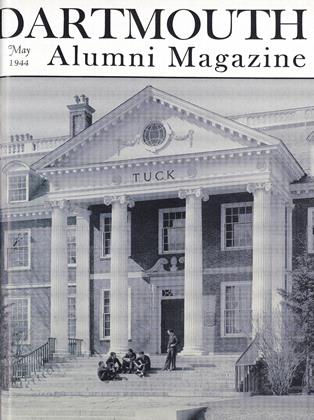THE COLLEGES HAVE TOLD themselves, and have been told by others, so many times that their efforts to purvey liberal education are a failure that apparently they have come to believe it themselves to the extent of casting about to find what's wrong and what should be remedied when things get back to the normal after the war. The one thing that hasn't been assessed seems to be the amount of truth in the accusation, and it may not be amiss to investigate this a little.
One may dismiss at once as chimerical any aspiration to score 100 per cent successes. The real question is what percentage of the finished product is manifestly below such a standard as is practically attainable. If it runs above 60, then there is some reason to be alarmed. The great trouble, however, is to find any benchmarks from which to measure.
We may assume that the great aim of liberal education is to produce men of cultivation, of a proper capacity for thinking, of aptitude for the none too easy process of living together politically and socially. The American colleges have gone in for mass production on so grandiose a scale that the results, so far as polished cultivation goes (in the stricter aesthetic sense), are bound to be disappointing. It is quite true in most communities that it would be difficult to identify the collegetrained by what they read, what they say, how they talk, what amusements they prefer. It is generally asserted that, in the case of most men, you'd never know they'd been to college if they didn't tell you about it. Perhaps one somewhat too readily charges failure to turn out finished products commensurate with the effort made.
"Too many men are going to college" is a striking statement that needs some clarification. Its corollary is the statement that too few men are going to college who really ought to go—partly because so many on whom college education seems to be wasted overcrowd the available space. Even so, the accepted American theory is that the more men given a collegiate training, the better, whether most of them show it or not; because the important thing is to raise, be it ever so little, the general average of intelligence among our citizenry.
Exposure for four years to the finer things of life should have some effect on even obdurate material. Something of cultivated appreciations is bound to stick; and though they may seem to produce an effect on very few, the colleges may with due diligence save some. The liberal arts colleges are not primarily seeking to fit men to earn a living, but rather to fit them to make the most of their lives when the living has been earned. With many, the effort is bound to fail. The question raised, however, is whether the real failures are so numerous as to support an indictment, and of that one may justly feel some doubt.
True it is that this mass production of college-bred citizens is not new, but has, been going on long enough to warrant expectation of a better American citizenship than, off-hand, we seem to be getting. But, while we may estimate unflatteringly what has been done, we usually fail to consider what has been avoided; that is, what would have been our condition if it had not been done. With all their failure to enhance scholarship, the colleges do not merit the charge that they have done harm. Of course they haven't. Their effects have not been as good as one could wish; but the country is immeasurably better than otherwise it would be, for all that.
SPRING, OR A REASONABLE FACSIMILE, BRINGS OUT THE SOFTBALL ADDICTS
 View Full Issue
View Full Issue
More From This Issue
-
 Article
ArticleTHE GREEN FLIES HIGH
May 1944 By ARTHUR SAMPSON -
 Class Notes
Class Notes1914
May 1944 By DR. WALLACE H. DRAKE, JOHN F. CONNERS -
 Lettter from the Editor
Lettter from the Editor'Round the Girdled Earth
May 1944 -
 Class Notes
Class Notes1917
May 1944 By MOTT D. BROWN JR., DONALD BROOKS -
 Class Notes
Class Notes1934
May 1944 By WILLIAM C. EMBRY -
 Class Notes
Class Notes1918
May 1944 By ERNEST H. EARLEY, DONALD L. BARR
P. S. M.
-
 Article
ArticleSea-Anchor for Dartmouth
January 1943 By P. S. M. -
 Article
ArticleNot So Useless
August 1943 By P. S. M. -
 Article
ArticleCafeteria, Table D'Hote?
June 1944 By P. S. M. -
 Article
ArticleThe Broadening Field
January 1945 By P. S. M. -
 Article
ArticleLarboard Watch, Ahoy!
August 1945 By P. S. M. -
 Article
ArticleIs Too Much Enough?
December 1945 By P. S. M.
Article
-
 Article
ArticleANNUAL GIFT OF $5,000 BY THE CLASS OF '79
November, 1025 -
 Article
ArticleWith Big Green Teams
July 1954 -
 Article
ArticleDino Wars Update
SEPTEMBER 1991 -
 Article
ArticleTHE DARTMOUTH
FEBRUARY 1930 By Albert I. Dickerson -
 Article
ArticleHE WROTE THE BOOK ON COLLEGE ADMISSIONS
APRIL 1991 By Lee Michaelides -
 Article
ArticleON THE LEVEL
March 1934 By S.H. Silverman '34

